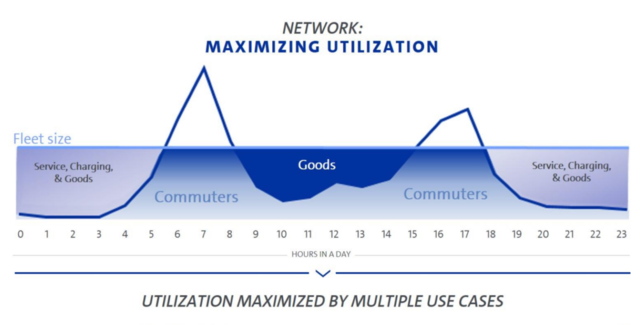This story was delivered to Business Insider Intelligence Transportation & Logistics Briefing subscribers hours before it appeared on Business Insider. To be the first to know, please click here.
Daimler, the parent company of Mercedes-Benz, revealed a new fully electric, autonomous concept car that can both ferry around passengers and deliver parcels, Bloomberg reports. Known as the “Vision Urbanetic,” the vehicle has an underlying chassis with two different “modules” that can be swapped in and out depending on what the car is transporting.

Business Insider Intelligence
The first module is an egg-shaped bus that can seat up to 12 passengers, while the second is a cargo version that has 353 cubic feet of storage over two levels, allowing it to fit up to 10 pallets. Daimler said the modules can be swapped out in under 2 minutes and that it hopes the vehicle will “redefine the future of mobility.”
Daimler plans to set up “mobility stations” designed to support fleets of Vision Urbanetic vehicles in urban areas. The automaker said these stations would perform maintenance on the cars, recharge them, and swap out the modules. Daimler also detailed an analytics system that would process and synthesize historical and real-time data to determine which module is needed and where.
For instance, if this system is fed camera data showing a crowd of people leaving a sporting event or concert, it could direct workers at a nearby mobility station to prepare a number of vehicles with the passenger bus modules. Conversely, if demand for passengers is low in the middle of the workday, the analytics system could direct workers to prepare the vehicles with the parcel delivery modules.
Daimler will face challenges getting this mobility station network up and running, but the company counts north of 368 dealers worldwide, many of which it could partially convert to mobility stations for the Vision Urbanetic cars.
The concept offers an early glimpse at Daimler’s strategy to maximize the uptime — and revenue-generating potential — of its self-driving cars. Autonomous cars will undoubtedly revolutionize the movement of goods and people, providing significantly cheaper and safer transportation options when they arrive.
But, for automakers, maximizing this opportunity will require experimenting with creative ways to ensure their cars are delivering packages or transporting people — and thus earning money — most of the day. Though only a concept car, Vision Urbanetic is Daimler’s first major effort to balance the parcel delivery opportunity with the ride-hailing opportunity for its autonomous cars.
Beyond ride-hailing and parcel delivery, Daimler could also conceivably partner with local governments and transit agencies to offer the Vision Urbanetic as a public transit option. As such, although Vision Urbanetic is a long way from hitting the roads, it should prompt competing carmakers to consider how they’ll derive as much revenue possible from their autonomous cars.
